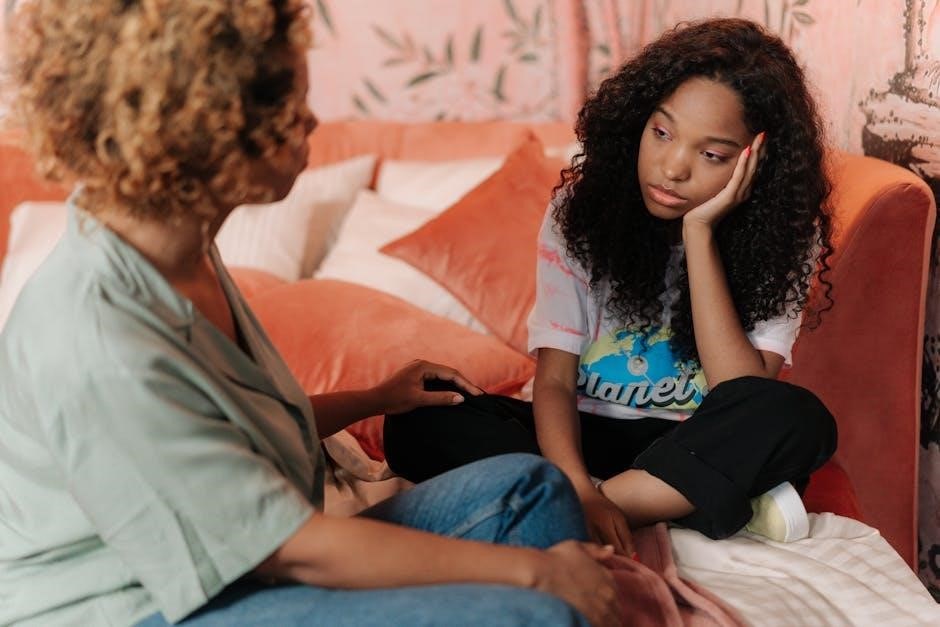
This guide explores the complexities of Black womanhood, offering insights into historical, sociocultural, and contemporary dynamics. It aims to foster empathy and understanding, bridging gaps between Black men and women through shared experiences and mutual respect.
Overview of the Book and Its Purpose
The Blackman’s Guide to Understanding the Blackwoman by Shahrazad Ali explores the complexities of Black relationships, rooted in historical and sociocultural dynamics. The book examines the legacy of slavery and its impact on Black family structures, offering insights into the challenges faced by Black men and women. It aims to foster mutual respect, understanding, and unity, providing a framework for Black men to navigate relationships with empathy and cultural awareness. The guide is not a prescriptive manual but a nuanced exploration of shared experiences.
Historical Context and Cultural Significance
The Blackman’s Guide to Understanding the Blackwoman delves into the historical roots of Black relationships, tracing back to the legacy of slavery and its enduring impact on family dynamics. It examines how systemic oppression shaped gender roles and interpersonal interactions within the Black community. The book highlights the cultural significance of understanding these dynamics, emphasizing the importance of unity and resilience in overcoming societal challenges. By exploring these themes, it provides a foundation for healing and growth within the Black community.
Author Background: Shahrazad Ali
Shahrazad Ali is a notable author known for The Blackman’s Guide to Understanding the Blackwoman, published in 1989, exploring Black relationships and cultural dynamics.
Biography and Contributions to Black Literature
Shahrazad Ali, born in 1947, is a prominent author known for her controversial yet impactful contributions to Black literature. Her book, The Blackman’s Guide to Understanding the Blackwoman, published in 1989, sparked significant dialogue about Black relationships and cultural dynamics. Ali’s work challenges societal norms, offering a raw perspective on race, gender, and identity. While her ideas have faced criticism, they remain a pivotal part of discussions on Black empowerment and unity, making her a notable figure in contemporary Black literature.
Critical Reception and Controversies Surrounding the Book
The Blackman’s Guide to Understanding the Blackwoman has sparked intense debate since its release in 1989. Critics argue that the book perpetuates harmful stereotypes about Black women, labeling it as divisive and misogynistic. Others praise its raw honesty and ability to provoke necessary conversations about race, gender, and relationships. The controversy highlights the book’s polarizing impact, leaving readers divided on its value as a tool for understanding or as a reflection of deeper societal issues within the Black community.

Understanding Black Womanhood
Black womanhood is a rich tapestry of resilience, cultural identity, and strength, shaped by historical struggles and modern societal challenges, emphasizing empowerment and collective upliftment.
Historical and Sociocultural Perspectives
Black womanhood is deeply rooted in the historical legacy of resilience and survival, shaped by the oppressive systems of slavery and systemic racism. Sociocultural norms have often marginalized Black women, yet they remain central to the preservation of cultural identity and community strength. Understanding their experiences requires acknowledging the interplay of historical trauma, societal expectations, and the enduring spirit of Black women in overcoming adversity and fostering collective upliftment within their communities.
Modern Challenges and Resilience
Black women today face modern challenges, including systemic racism, gender bias, and economic disparities. Despite these obstacles, they demonstrate remarkable resilience through education, entrepreneurship, and community leadership. Their ability to navigate contemporary societal pressures while maintaining cultural identity and strength highlights their pivotal role in fostering unity and progress within the Black community. This resilience underscores the importance of understanding and supporting their journeys in the pursuit of equity and empowerment.

Keys to Building Healthy Relationships
Building healthy relationships requires mutual respect, open communication, and emotional intelligence, fostering trust and understanding for a strong, unified partnership.
Communication Strategies and Emotional Intelligence
Effective communication and emotional intelligence are cornerstone strategies for fostering healthy relationships. Active listening, expressing empathy, and understanding non-verbal cues are essential for bridging gaps. These approaches help navigate conflicts and foster mutual respect, enabling deeper connections. By prioritizing open dialogue and emotional awareness, individuals can build trust and create a foundation for meaningful interactions. Such strategies are crucial for fostering unity and growth within the Black community, as emphasized in the guide.
Empowerment Through Mutual Respect and Understanding
Empowerment through mutual respect and understanding is a cornerstone of fostering balanced relationships. By valuing each partner’s unique strengths and perspectives, both individuals can thrive. Open communication and shared goals create a supportive environment, allowing each person to grow. This collaborative approach ensures that empowerment is a shared journey, enriching the relationship and strengthening the bond within the Black community. Mutual respect fosters a culture of appreciation, where both partners feel valued and empowered to contribute meaningfully to their shared life.

Navigating Cultural and Generational Differences
Navigating cultural and generational differences requires understanding historical contexts and evolving values. Bridging these gaps fosters unity and strengthens relationships within the Black community.
Bridging Gaps Between Traditional and Contemporary Values
Bridging gaps between traditional and contemporary values involves reconciling historical norms with modern perspectives. This process fosters mutual respect and understanding, enabling Black men and women to navigate cultural shifts while preserving heritage. By acknowledging the evolution of societal roles, individuals can create harmonious relationships that honor both past and present. This balance is crucial for building a unified and resilient Black community.
The Role of Community and Family in Relationship Dynamics
Community and family play pivotal roles in shaping relationship dynamics within the Black experience. They provide cultural grounding, shared values, and emotional support, fostering resilience. Strong familial bonds and communal ties help navigate challenges, promoting understanding and unity. By leaning on these networks, Black men and women can build relationships rooted in mutual respect and cultural heritage, ultimately strengthening the fabric of their community.

Addressing Misconceptions and Stereotypes
This section challenges false narratives about Black men and women, fostering unity by promoting accurate understanding rooted in history and cultural insights.
Debunking Myths About Black Men and Black Women
This section challenges stereotypes and misconceptions that fuel division within the Black community. By examining historical and cultural contexts, it reveals how myths about Black men and women are rooted in systemic oppression rather than truth. The book emphasizes the importance of understanding these narratives to foster genuine unity and mutual respect, offering a path to heal and rebuild relationships based on shared experiences and accurate perspectives.
promoting Unity in the Face of Societal Challenges
The book underscores the importance of unity as a collective response to systemic oppression. By addressing historical and cultural divides, it encourages Black men and women to collaborate in overcoming societal barriers. Open dialogue and mutual support are highlighted as essential tools for fostering resilience and solidarity. The guide advocates for a united front, emphasizing that strength lies in shared experiences and the commitment to progress together, rather than allowing external forces to dictate internal dynamics.
Practical Advice for Black Men
Practical advice for Black men focuses on fostering open communication, empathy, and mutual respect. It emphasizes understanding Black women’s experiences and supporting their growth and empowerment.
Active Listening and Empathy in Relationships
Active listening and empathy are crucial for fostering deeper connections. By truly hearing and understanding Black women’s experiences, men can break down barriers and build trust. Empathy involves validating emotions and perspectives, creating a safe space for open dialogue. This approach encourages mutual respect and strengthens relationships, fostering a culture of unity and understanding within the Black community.
Supporting Black Women’s Empowerment and Growth
Supporting Black women’s empowerment involves championing their education, career goals, and personal aspirations. Men can play a vital role by advocating for their partners’ autonomy and self-worth. This includes celebrating their achievements and providing a nurturing environment for growth. By fostering mutual respect and understanding, Black men contribute to the collective progress of the community, ensuring that Black women thrive in all aspects of life, which ultimately strengthens familial and societal bonds.
The journey of understanding fosters unity and collective progress. By embracing mutual respect and empathy, Black men and women can overcome societal challenges, ensuring a brighter, united future.
Reflections on the Importance of Understanding and Unity
Understanding and unity are vital for fostering resilience and collective progress; By reflecting on shared experiences and historical contexts, Black men and women can dismantle societal barriers. This guide emphasizes the importance of empathy, mutual respect, and collaboration to strengthen relationships and communities. Unity empowers individuals to challenge systemic oppression and create a brighter future for generations to come, ensuring a legacy of strength and solidarity within the Black community.
Resources for Further Learning and Growth
For deeper exploration, readers can access Shahrazad Ali’s works, including PDF versions of The Blackman’s Guide to Understanding the Blackwoman. Additional resources include books on Black relationships, academic journals, and community organizations focused on racial unity. Online platforms like Open Library and Internet Archive offer free downloads, while initiatives like the African People of Love Repatriation Movement provide educational tools. Engaging with these materials fosters continuous learning and personal growth, enriching one’s understanding of Black dynamics and cultural empowerment.